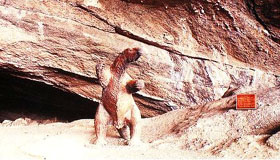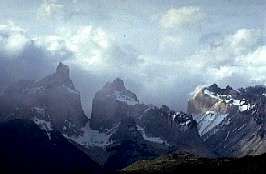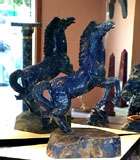- 15 Days with 5-Day Cruise: Punta Arenas to Ushuaia
M/V Stella Australis or M/V Ventus Australis
Departures September thru April
Click here for Departure Dates
- 15 Days
M/V Stella Australis or M/V Ventus Australis
Day 1: Depart
Home City
Day 2: Arrive in Buenos Aires Morning arrival and transfer to your selected hotel.In the afternoon,
you will have a private tour of the "Paris of South America."  Drive
down 9th of July Avenue, the widest street in the world, past the Colon
Opera House to the Plaza de Mayo. The plaza is faced by the pink Presidential
Palace and the National Cathedral, which houses the tomb of the liberator,
San Martin. Next visit "La Boca," the old port district with
its pastel houses and shops. You will have time to browse for souvenirs.
Drive
down 9th of July Avenue, the widest street in the world, past the Colon
Opera House to the Plaza de Mayo. The plaza is faced by the pink Presidential
Palace and the National Cathedral, which houses the tomb of the liberator,
San Martin. Next visit "La Boca," the old port district with
its pastel houses and shops. You will have time to browse for souvenirs.
Day 3: In Buenos Aires A day completely free to explore on your own. Sip traditional tea at
a local teashop or visit one of the estancias on the pampas. This evening
enjoy a typical Argentine beef dinner followed by a folklore show and
Tango performance. (B, D)
Day 4: Buenos
Aires/Tierra del Fuego/Embark Cruise Transfer to the municipal airport in Buenos Aires to board a flight
to Ushuaia, the southernmost commercial airport in the world on the
island of Tierra del Fuego, where the Andes meet the Beagle Channel.
Transfer directly to the pier to commence your exciting adventure on
board the Australis cruise around the southern tip of South America
to Punta Arenas, Chile. (B, D)
Important Note: You may substitute the cruise with an air sector from Ushuaia to Punta
Arenas, which operates Monday-Friday from NOV-MAR. Approximate cost
is $160 per person including taxes.
(Click here for packages to extend
your stay at Ushuaia on Tierra del Fuego.)
 Ushuaia, Tierra del Fuego, Argentina, the 'Southernmost City in the World'
Ushuaia, Tierra del Fuego, Argentina, the 'Southernmost City in the World' |
| |
|
M/V Stella Australis |
Day
5: Cape Horn and Wulaia Bay Around the break of dawn, Ventus Australis crosses Nassau Bay and enters the remote archipelago that comprises Cape Horn National Park. Weather and sea conditions permitting, you will go ashore on the windswept island that harbors legendary Cape Horn (Cabo de Hornos). Discovered in 1616 by a Dutch maritime expedition — and named after the town of Hoorn in West Friesland — Cape Horn is a sheer 425-meter (1,394-foot) high rocky promontory overlooking the turbulent waters of the Drake Passage. For many years it was the only navigation route between the Pacific and Atlantic, and was often referred to as the 'End of the Earth.' The park was declared a World Biosphere Reserve by UNESCO in 2005. The Chilean navy maintains a permanent lighthouse on the island, staffed by a lightkeeper and his family, as well as the tiny Stella Maris Chapel and modern Cape Horn Monument (currently awaiting repair after being damaged by fierce winds).
Sailing back across Nassau Bay, you anchor at fabled Wulaia Bay, one of the few places in the archipelago where the human history is just as compelling as the natural environment. Originally the site of one of the region's largest Yámana aboriginal settlements, the bay was described by Charles Darwin and sketched by Captain FitzRoy in the 1830s during their voyages on HMS Beagle. This area is also renowned for its mesmerizing beauty and dramatic geography. After a visit to the Australis-sponsored museum in the old radio station — which is especially strong on the Yámana people and European missionaries in the area — passengers have a choice of three hikes (of increasing degrees of difficulty) that ascend the heavily wooded mountain behind the bay. On all of these you stroll through an enchanted Magellanic forest of lengas, coigües, canelos and ferns to reach panoramic viewpoints overlooking the bay. (B, L, D)
 Day 6: Pía Glacier - Garibaldi Glacier You continue overnight around the western end of Tierra del Fuego via the very narrow Gabrial Channel, Magdalena Channel and Cockburn Channel. After rounding the remote Brecknock Peninsula, Ventus Australis tacks eastward and enters the Beagle Channel again. By morning you are entering Pia Fjord and boarding the Zodiacs for a shore excursion to Pia Glacier. After disembarking you take a short hike to gain a panoramic view of the spectacular glacier, which extends from the mountaintops down to the sea. Or you can opt for a longer much more difficult walk up a lateral moraine of the old Pia Glacier. No one knows for certain how the hulking mass of snow and ice got its feminine moniker, but one theory says it was named for Princess Maria Pia of Savoy (1847-1911), daughter of the Italian king.
Day 6: Pía Glacier - Garibaldi Glacier You continue overnight around the western end of Tierra del Fuego via the very narrow Gabrial Channel, Magdalena Channel and Cockburn Channel. After rounding the remote Brecknock Peninsula, Ventus Australis tacks eastward and enters the Beagle Channel again. By morning you are entering Pia Fjord and boarding the Zodiacs for a shore excursion to Pia Glacier. After disembarking you take a short hike to gain a panoramic view of the spectacular glacier, which extends from the mountaintops down to the sea. Or you can opt for a longer much more difficult walk up a lateral moraine of the old Pia Glacier. No one knows for certain how the hulking mass of snow and ice got its feminine moniker, but one theory says it was named for Princess Maria Pia of Savoy (1847-1911), daughter of the Italian king.
Making your way further west along the Beagle Channel, you enter another long fjord and drop anchor near Garibaldi Glacier for another shore excursion. Garibaldi is one of only three glaciers in Patagonia gaining mass rather than staying the same or slowly shrinking. This time you hike through virgin Magellanic forest to a glacial waterfall, a towering wall of ferns and moss, and spectacular viewpoints looking down on the glacier and fjord. The walk is demanding — very steep, negligible trail, rough footing — and not for everyone. For those who choose to stay onboard, the captain will point the bow towards the beautiful sky blue Garibaldi Glacier so everyone can enjoy the panoramic view from the upper decks. (B, L, D)
Day 7: Agostini Sound - Águila Glacier - Cóndor Glacier You sail through the Cockburn Channel early in the morning, and enter Agostini Sound. From there it is possible to see the glaciers that descend from the middle of the Darwin Mountain Range -- some of them reaching the water. This morning you will disembark and go for an easy walk around a lagoon, which was formed by the melting of the Águila Glacier. You will reach a spot right in front of that glacier with stunning views. In the afternoon,you approach the Condor Glacier via Zodiac -- and hopefully see some of the abundant Andean Condors in the area. (B, L, D)
Day 8: Arrive in Punta Arenas and Transfer to Paine National Park Early
in the morning you will disembark on Magdalena Island,  home of a colony
of over 120,000 penguins in different stages of breeding. You will then
take a walk to San Isidro Lighthouse, which used to guide the explorer
sailors crossing the Strait of Magellan. Afterwards sail into Punta
Arenas. One adventure ends and another begins. You will be picked up at the pier and transferred to your hotel of choice in Paine National Park. The drive is about six hours via paved and then a well-graded road. You will spend four nights in the park at your choice of all-inclusive properties: Hosteria Las Torres, Hosteria Rio Serrano, Tierra Patagonia or Explora en Patagonia. NOTE: Paine National Park packages are NOT included in the quotes. Click here for rates at the lodges. (B, D)
home of a colony
of over 120,000 penguins in different stages of breeding. You will then
take a walk to San Isidro Lighthouse, which used to guide the explorer
sailors crossing the Strait of Magellan. Afterwards sail into Punta
Arenas. One adventure ends and another begins. You will be picked up at the pier and transferred to your hotel of choice in Paine National Park. The drive is about six hours via paved and then a well-graded road. You will spend four nights in the park at your choice of all-inclusive properties: Hosteria Las Torres, Hosteria Rio Serrano, Tierra Patagonia or Explora en Patagonia. NOTE: Paine National Park packages are NOT included in the quotes. Click here for rates at the lodges. (B, D)
Days
9-11: In Paine National Park All excursions are included in your hotel package. (B, L, D daily)
 Day 12: Paine National Park to Santiago Early morning van transfer directly from Paine National Park to Punta Arenas airport for an afternoon flight to Santiago.
Day 12: Paine National Park to Santiago Early morning van transfer directly from Paine National Park to Punta Arenas airport for an afternoon flight to Santiago.  Meeting service and transfer to your selected hotel. (B)
Meeting service and transfer to your selected hotel. (B)
Day 13: In Santiago You will have the morning to rest and refresh before an afternoon motorcoach city tour. Enjoy visits to Santa Lucia Hill and San Cristobal Hill before stopping at Bellavista, Santiago’s Bohemian district replete with art galleries, restaurants and theaters. Time permitting, stop to see a lapis lazuli workshop. Last stop is a visit to the Pablo Neruda Museum, called “La Chascona”. (B)
Day 14: PM Depart Santiago You will have this day free for last minute shopping and sightseeing on your own before an evening departure back home. So many memories and so many experiences you will treasure forever! (B)
Day 15: Arrive Home City
- 15 Days
M/V Stella Australis or M/V Ventus Australis
Day 1: Depart
Home City
Day 2: Arrive in Santiago Afternoon private Santiago City Tour
Day 3: In Santiago
Day 4: Santiago to Punta Arenas/Paine National Park (B, D)
Day 5-7: In Paine National Park (B daily)
Day 8: Paine National Park
to Punta Arenas/Embark Australis Cruise After a welcoming toast and introduction of captain and crew, the ship departs for one of the remotest corners of planet Earth. During the night you cross the Strait of Magellan and enter the labyrinth of channels that define the southern extreme of Patagonia. The twinkling lights of Punta Arenas gradually fade into the distance as you enter the Whiteside Canal between Darwin Island and Isla Grande de Tierra del Fuego. (B, D)

Punta Arenas, Chile, is the most prominent settlement on the Strait of Magellan
|
Ship Information - Deck Plans - Photo Gallery
or
Ship Information - Deck Plans - Photo Gallery
Day
9: Ainsworth Bay/Marinelli Glacier/Tucker Islet By dawn the ship is sailing up Admiralty Sound (Seno Almirantazgo), a spectacular offshoot of the Strait of Magellan that stretches nearly halfway across Tierra del Fuego. The snowcapped peaks of Karukinka Natural Park stretch along the north side of the sound, while the south shore is defined by the deep fjords and broad bays of Alberto de Agostini National Park. You go ashore at Ainsworth Bay, which harbors copious bird life and a colony of southern elephant seals which can sometimes be spotted from the Zodiacs. Two guided excursions are available: one is along the edge of a stream, peat bog and beaver habitat to a waterfall-and-moss-covered rock face tucked deep inside a pristine sub-polar forest; the other is a more strenuous hike along the crest of a glacial moraine. Both afford views of Marinelli Glacier and the Darwin Mountains. Leaving the Ainsworth Bay tour behind, you sail west along the sound to the Tucker Islets. After lunch, you board the Zodiacs again for a close-up view of the Magellan penguins that inhabit the tiny islands. More than 4,000 penguins use Tucker as a place to nest, give birth and nurture their chicks. Many other bird species also frequent the area including king cormorants, oystercatchers, Chilean skuas, kelp geese, dolphin gulls, eagles and even the occasional Andean condor. In September and April — when the penguins live elsewhere — this excursion is replaced by a short walk to a glacier at nearby stunning Brookes Bay. (B, L, D)
Day 10: Garibaldi and Pia
Glaciers You sail overnight around the western end of Tierra del Fuego via the very narrow Gabrial Channel, Magdalena Channel and Cockburn Channel. After rounding the remote Brecknock Peninsula, Ventus Australis tacks eastward and enters the Beagle Channel again. By morning you head for Pia Fjord and boarding the Zodiacs for a Pia Glacier tour. After disembarking you take a short hike to gain a panoramic view of the spectacular glacier, which extends from the mountaintops down to the sea. Or you can opt for a longer, much more difficult walk up a lateral moraine of the old Pia Glacier. No one knows for certain how the hulking mass of snow and ice got its feminine moniker, but one theory says it was named for Princess Maria Pia of Savoy (1847-1911), daughter of the Italian king.
Back onboard the ship, you continue east along the Beagle Channel through an area called Glacier Alley. Living up to its name, the passage features a number of impressive tidewater glaciers flowing down from the Darwin Mountains and Darwin Ice Sheet on the north shore. Most of them named after European countries — Holland, Italy, Germany, Spain and France. (B, L, D)
 Day
11: Wulaia Bay and Cape Horn During the early morning you navigate the narrow Murray Channel between Navarino and Hoste islands and drop anchor at historic Wulaia Bay, one of the few places in the archipelago where the human history is just as compelling as the natural environment. Originally the site of one of the region's largest Yámana aboriginal settlements, the bay was described by Charles Darwin and sketched by Captain FitzRoy in the 1830s during their voyages on the HMS Beagle. This area is also renowned for its mesmerizing beauty and dramatic geography. After a visit to the Australis-sponsored museum in the old radio station -- which is especially strong on the Yámana people and European missionaries in the area — passengers have a choice of three hikes (of increasing degrees of difficulty) that ascend the heavily wooden mountain behind the bay. On all of these you will be strolling through an enchanted Magellan forest of lengas, coigües, canelos, ferns, and other endemic fauna to reach a panoramic viewpoint overlooking the bay. Before leaving Wulaia Bay, drop something into the wooden mail barrel inside the museum - letters or postcards meant to be hand delivered by future travelers - an ancient mariner tradition revived by Australis. (B, L, D)
Day
11: Wulaia Bay and Cape Horn During the early morning you navigate the narrow Murray Channel between Navarino and Hoste islands and drop anchor at historic Wulaia Bay, one of the few places in the archipelago where the human history is just as compelling as the natural environment. Originally the site of one of the region's largest Yámana aboriginal settlements, the bay was described by Charles Darwin and sketched by Captain FitzRoy in the 1830s during their voyages on the HMS Beagle. This area is also renowned for its mesmerizing beauty and dramatic geography. After a visit to the Australis-sponsored museum in the old radio station -- which is especially strong on the Yámana people and European missionaries in the area — passengers have a choice of three hikes (of increasing degrees of difficulty) that ascend the heavily wooden mountain behind the bay. On all of these you will be strolling through an enchanted Magellan forest of lengas, coigües, canelos, ferns, and other endemic fauna to reach a panoramic viewpoint overlooking the bay. Before leaving Wulaia Bay, drop something into the wooden mail barrel inside the museum - letters or postcards meant to be hand delivered by future travelers - an ancient mariner tradition revived by Australis. (B, L, D)
Day 12: Arrival in Ushuaia/Buenos
Aires Sightseeing in Ushuaia and transfer to the airport for
your flight to Buenos Aires. (B)
Day 13: Buenos Aires Private sightseeing in Buenos Aires and evening motorcoach ride to Tango Show with dinner. (B,
D)
Day 14: Depart Buenos Aires (B)
Day 15: Arrive Home City


